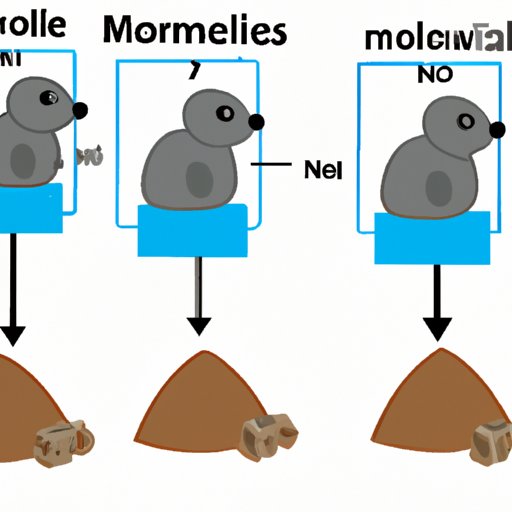
Introduction
Chemistry is a fascinating and complex subject that helps us understand the world around us. One of the most important concepts in chemistry is the calculation of moles. Moles are a unit of measurement used to express the number of particles in a substance. Understanding how to calculate moles is essential for anyone studying chemistry because it enables them to make accurate predictions about chemical reactions and solve real-world problems.
A Step-by-Step Guide to Calculating Moles in Chemistry
What is a Mole?
Before we dive into the calculations, let’s define what a mole is. A mole is the amount of a substance that contains the same number of particles as there are atoms in 12 grams of pure carbon-12. This number is known as Avogadro’s number, which is approximately 6.02 x 10^23.
Calculating Moles: The Formula
To calculate the number of moles in a substance, we use the following formula:
moles = mass / molar mass
The mass refers to the amount of the substance, and the molar mass is the mass of one mole of the substance, which can be found on the periodic table.
Step-by-Step Instructions
Let’s say we want to find the number of moles in 10 grams of sodium chloride (NaCl). Here are the step-by-step instructions:
1. Find the molar mass of NaCl on the periodic table. We see that the molar mass of NaCl is 58.44 g/mol.
2. Divide the mass of NaCl by its molar mass to get the number of moles. In this case, 10 grams divided by 58.44 g/mol is 0.171 moles.
Visual Aids
Sometimes, visuals can help us understand complex concepts better. Here is a helpful diagram that shows the steps involved in calculating moles:

The Importance of Calculating Moles in Chemical Reactions
Mole calculations are essential for predicting the outcomes of chemical reactions. By knowing the number of moles of reactants and products, chemists can determine how much of each substance is needed for a reaction to occur, how much of each substance will be produced, and the overall yield of the reaction.
Real-World Examples
Mole calculations are used in real-world situations every day. For example, in the food industry, chemists use mole calculations to determine the amount of ingredients needed to make a certain number of servings of a product. In medicine, mole calculations are used to determine the concentration of a drug in a patient’s bloodstream.
Common Mistakes to Avoid When Calculating Moles
Like with any type of calculation, there are common pitfalls to avoid when calculating moles. One of the most common mistakes is using the wrong conversion factor or not accounting for significant figures.
Tips for Avoiding Mistakes
To avoid mistakes, it’s important to use the correct conversion factor and pay attention to significant figures. Always double-check your calculations and be mindful of any rounding errors.
Real-World Examples of Mole Calculations
Let’s look at some practical examples of how to use mole calculations to solve everyday problems.
Calculating Concentration
Suppose you have a solution that contains 25 grams of sodium chloride (NaCl) dissolved in 500 milliliters of water. To calculate the concentration of the solution, we use the following formula:
concentration (in moles per liter) = moles of solute / volume of solution (in liters)
1. Calculate the number of moles of NaCl.
moles = mass / molar mass = 25 g / 58.44 g/mol = 0.427 moles
2. Convert the volume of the solution from milliliters to liters.
volume = 500 mL / 1000 mL/L = 0.5 L
3. Now we can calculate the concentration.
concentration = 0.427 mol / 0.5 L = 0.854 M
Therefore, the concentration of the solution is 0.854 moles per liter.
How to Convert Between Moles and Other Units of Measurement
It’s possible to convert between moles, grams, atoms, and other units of measurement. Understanding how to convert between these units is crucial for performing accurate mole calculations.
The Conversions
Here are the formulas for converting between moles, grams, and atoms:
moles = mass / molar mass
grams = moles x molar mass
atoms = moles x Avogadro’s number
Examples
Let’s say we want to convert 5 grams of methane (CH4) to moles.
1. Find the molar mass of methane. We can do this by adding up the molar masses of the elements that make up the compound: 4 x 1.0079 (the molar mass of hydrogen) + 1 x 12.0107 (the molar mass of carbon) = 16.0425 g/mol.
2. Plug in the values: moles = 5 g / 16.0425 g/mol = 0.3118 moles.
Mastering Mole Calculations: Practice Problems and Solutions
The best way to master mole calculations is through practice. Here are some practice problems to help you build your skills:
1. How many moles are in 25 grams of ammonium nitrate (NH4NO3)?
2. What is the molar mass of magnesium sulfate (MgSO4)?
3. How many grams of copper (II) chloride (CuCl2) are needed to make 0.2 moles of the compound?
Why Moles Matter: Exploring the Role of Moles in the Periodic Table and Beyond
Mole calculations have played a significant role in the development of the periodic table and our understanding of the properties of different elements. By understanding how to calculate moles, chemists can predict the behavior of elements in various chemical reactions and make new discoveries.
Conclusion
Mole calculations are an integral part of chemistry. By understanding what a mole is and how to perform calculations, you can solve real-world problems and make accurate predictions about chemical reactions. Remember to avoid common mistakes, practice often, and continue to explore the fascinating world of chemistry.




